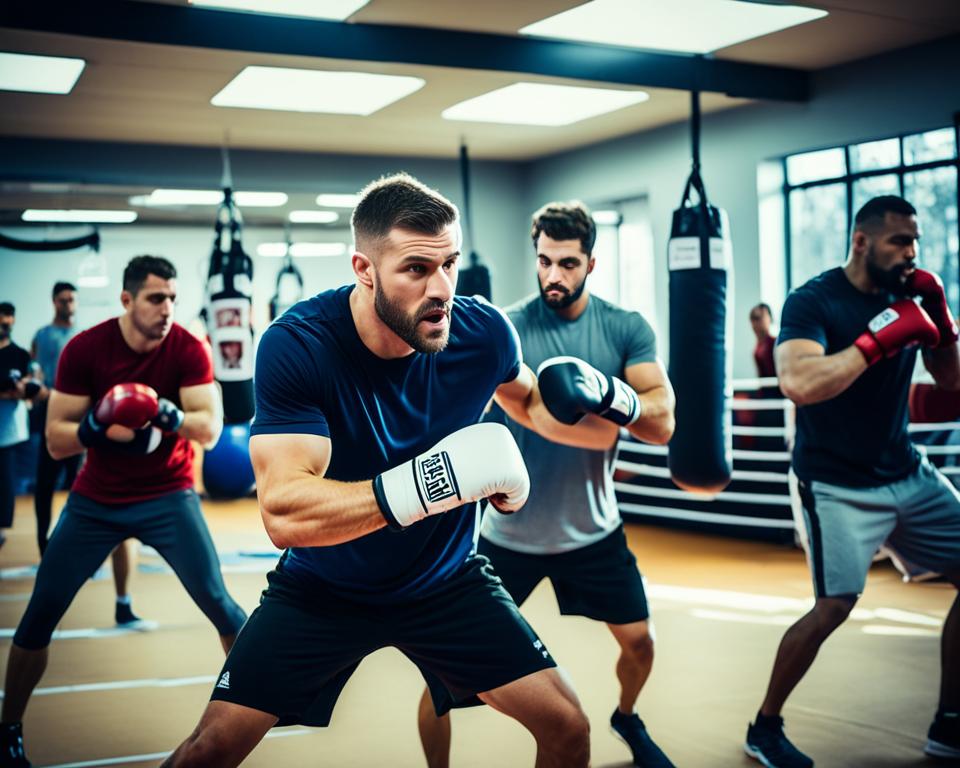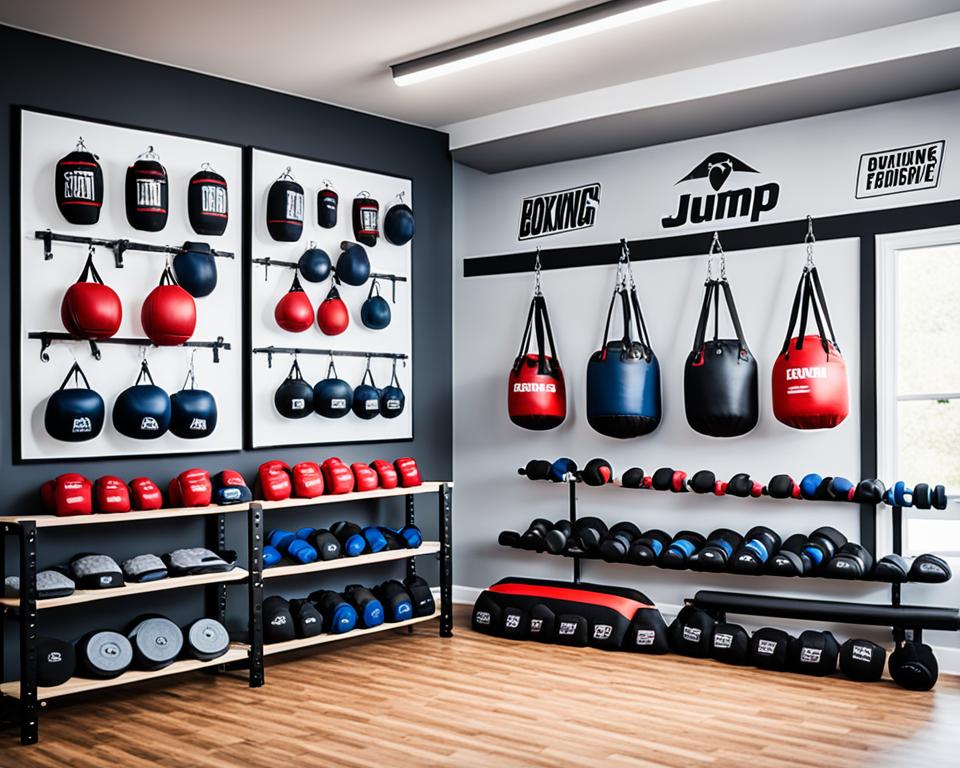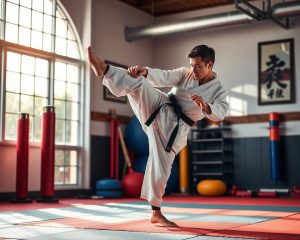
Get ready for a life-changing experience in boxing. This guide will give you everything you need to excel, whether you’re just starting or have some experience. Learn from the best through lessons and practice that focus on key skills and strategies.
Dive into boxing’s past and its benefits, understanding its deep impact. You will learn essential stances and movements, and how to throw punches properly. Perfecting your technique and generating power are key to becoming a strong boxer.
You’ll also learn vital defensive moves to avoid hits and stay alert in the ring. This journey will push you physically and mentally, building endurance, discipline, and a champion’s mindset.
Read interesting things at : web-quanto
Key Takeaways
- Comprehensive guide to mastering the art of boxing
- Learn from expert coaches and trainers
- Develop a solid foundation in boxing fundamentals
- Discover techniques for power, accuracy, and defense
- Enhance physical and mental conditioning for better performance
Introduction to Boxing Fundamentals
Boxing is a combat sport loved for centuries. It started long ago around the world and has grown into many forms. Today, people see boxing as both fun and helpful for their body and mind. We will look into the boxing fundamentals, its history, and the benefits it brings.
The Origins and History of Boxing
Boxing began in ancient times. It was a way to defend oneself, have fun, and sometimes as part of a ritual. Places like ancient Egypt, Greece, and Rome showed signs of early boxing. People back then used their bare hands or basic wraps to fight.
As time went on, boxing changed. Gloves, weight categories, and rules got introduced. In the 18th century, the Marquess of Queensberry rules gave boxing its modern base. Since then, boxing has been a sport that captivates many, from names like Muhammad Ali to today’s champions.
The Benefits of Boxing Training
- Boxing boosts your heart health, making you more fit.
- It also makes your muscles strong and powerful.
- You’ll become quicker and more coordinated as you learn to move and punch better.
- Boxing can boost your confidence and make you more disciplined.
No matter if you’re new or experienced, knowing the boxing fundamentals, its history, and the benefits is important. It’s a great first step to becoming a good fighter and a better person.
“Boxing is the ultimate challenge. There’s nothing that can compare to testing yourself the way you do every time you step in the ring.” – Sugar Ray Leonard
Essential Boxing Stance and Footwork
Getting the right boxing stance and footwork down is key for any boxer. It’s the first step to learning good techniques and moves in the ring. You’ll learn about the strong and balanced stances and the footwork you’ll need to attack and move well.
Your boxing stance is really important for how you move and where you get your power from. Having a stable stance lets you use your legs to push off, keep balanced, and react fast to what your opponent does. Here’s how to stand:
- Keep your feet the width of your shoulders apart, with one slightly in front of the other
- Bend your knees, with your weight the same on both feet
- Keep your hands up by your face, elbows close to protect your chin
- Always keep your chin down and your eyes on your opponent
Good boxing footwork is crucial for owning the ring, getting ready to attack, and dodging punches. You’ll want to get really good at a few key moves:
- The basic shuffle step: Slide your feet from side to side while keeping your balance
- The pivot step: Twist your body by spinning on the ball of one foot
- The slip step: Quickly move your weight to the side to avoid getting hit
- The angle step: Shift your position to get a better angle for attacking
Always keep in mind that your boxing stance and footwork are the cornerstones of how you move and fight in the ring. If you practice lots and do drills, you’ll get great at these basic moves. Then, you can pull them off in fights with skill and confidence.
“The secret to a good boxing stance is to keep your weight evenly distributed, your feet shoulder-width apart, and your body balanced and ready to move in any direction.” – Muhammad Ali
Mastering the Jab and Straight Punches
The jab and straight punches are key for boxers. They help set up powerful combos and defend. You can control distance and time by using these techniques well.
The Importance of Proper Punch Technique
Using the right technique for jabs and straights is crucial. It’s about the way your body aligns and your limbs move. Each little detail helps you hit harder and more accurately. Focus on the right muscle memory and body actions. This will let you throw punches that keep your rivals unsteady.
Developing Power and Accuracy
Jabs and straights are simple on the surface. But to really make them strong and on target takes work. You need to know about hip movements, the way your shoulders line up, and how to shift your weight. Try out different styles. Practice them over and over. This will boost the power and accuracy of your punches. Soon, you’ll be a more dynamic and skilled boxer.
“The jab is the most important punch in boxing. It’s the foundation of everything.” – Muhammad Ali
To succeed in boxing, focus on the jab and straight punches. Perfecting these basics improves both your attack and defense. Keep training hard and sticking to the right form. You’ll be well on your way to success in the ring.
Hooks, Uppercuts, and Other Punch Varieties
In the world of boxing, learning the basics of the jab and straight punches is vital. But, to be a complete fighter, you must also discover hooks, and uppercuts. These strong punches make your attack diverse and surprise your opponent. They lay the foundation for crafting complex punch combinations and punch sequences that keep your adversary guessing.
Mastering the Hook Punch
The hook punch is powerful, needing you to twist your hips and body. A good hook can really hit your opponent hard in the head or body. To get good at it, stand strong, twist your hips for power, and move your arm in a circle.
Unleashing the Uppercut
The uppercut moves upward, aiming at your opponent’s chin or body. Use your core and hips to make this punch powerful. Good footwork, perfect timing, and fast delivery are crucial for strong uppercuts.
Incorporating Combinations and Sequences
Boxing’s real challenge is mixing punch combinations and punch sequences. By combining jabs, hooks, and uppercuts, you can surprise your rival with many hits. Try different punch combinations and punch sequences to see what fits your style best. This can make opportunities for more hits.
Remember, mastering hooks, uppercuts, and other punches is an interesting journey, not just a goal. Keep practicing, perfect your moves, and be open to new strategies. This is how you become a complete fighter in boxing.
Defensive Boxing Techniques
In boxing, defense is just as important as attacking. Learning the right defense moves can make you win more fights. We will talk about important defensive moves here like slips, bobs, weaves, parrying, and blocking.
Slips, Bobs, and Weaves
Slipping, bobbing, and weaving are the basics of defense in boxing. They let you avoid getting hit by moving your head and body. Slipping means you move your head to the side to dodge a punch. Bobbing is about bending your knees and moving your head down and back up. Weaving is a smooth movement, letting you move around punches and your opponent.
Learning these moves takes practice, but it’s worth it. Doing them well helps you hit back more and stops your opponent from hitting you much.
Parrying and Blocking Punches
Boxers also use parrying and blocking to stay safe. Parrying means you use your arms to push away punches. It can mess up your opponent’s timing. Blocking is about stopping punches with your arms or body to lessen the impact.
You need to be quick and have good footwork to use these moves. But they’re very helpful in a match. Parrying and blocking help you control the game, attack yourself, and stay ahead of your opponent.
“The best defense is a good offense, but the best offense is a good defense.” – Muhammad Ali
Keep in mind, in boxing, defense isn’t just to stay safe. It’s about finding chances to hit back and win. Getting good at defense will protect you and help you take charge in the ring.
Conditioning and Endurance Training
To get ready for boxing, you need to work hard on your body and stamina. You should train a lot to get the strength, energy, and speed you need. This will make you perform better in a fight. In this part, I will talk about different exercises like running and lifting weights that can make you better.
Cardiovascular Training for Boxing Conditioning
Building up your heart and lung strength is key for boxing. Running, biking, or swimming can help boost your stamina. It’s also important to do interval training. This means you switch between fast and slow exercise to get ready for how boxing matches are.
Strength Training for Boxing Endurance
To be a good boxer, you need strong muscles. Exercises like squats, deadlifts, and pull-ups work many muscles at once. This makes your whole body strong. It also helps you hit harder and move quicker in the ring.
Sport-Specific Drills for Boxing Conditioning
Boxing-specific exercises like shadow boxing and hitting the heavy bag are crucial. They help you get better at the exact moves you’ll use in a fight. Sparring with a partner also improves your timing and skills.
| Training Aspect | Benefits |
|---|---|
| Cardiovascular Training | Improved overall endurance and stamina |
| Strength Training | Increased muscular power and punching force |
| Sport-Specific Drills | Enhanced movement patterns, hand-eye coordination, and timing |
A good mix of cardio, strength, and boxing-specific training is the way to go. This helps develop the physical skills you need to shine in the ring. Remember, training hard and being disciplined is crucial for boxing success.

Boxing Lessons: A Comprehensive Guide
Becoming a good boxer means working hard and knowing the sport deeply. This guide will cover everything you need to know to improve your technique, strategy, and how you train. By the end, you’ll know the key points to remember for each aspect of boxing.
We start with the basics like the right stance and how to move your feet. Then, we move on to key punches like jabs and uppercuts. You’ll also learn how to defend yourself using methods like slipping and blocking hits.
Getting in shape is a big part of boxing. It’s not just about physical toughness but also mental focus. We’ll also help you choose the best place to train and the right coach to guide you.
It’s essential to not only be good at the moves but also have a winning attitude. This section will focus on the mental side of boxing and how to plan your fights. You’ll learn advanced strategies to beat your rivals.
This guide will also show you how boxing can boost your general fitness. You’ll find out how cross-training can make you a better boxer both inside and outside the ring.
At the end of the day, you’ll understand what makes boxing an art. This knowledge will help you become a skilled and self-assured fighter, ready to take on the sport.
Key Takeaways
- Mastery of the fundamental boxing techniques, including stance, footwork, jabs, straight punches, hooks, and uppercuts
- Proficiency in defensive skills, such as slips, bobs, weaves, parrying, and blocking
- Importance of conditioning, endurance training, and developing a winning mindset
- Guidance on choosing the right boxing gym and coach to support your growth
- Strategies for incorporating boxing into your overall fitness routine and cross-training
| Technique | Description | Benefits |
|---|---|---|
| Jab | A quick, straight punch thrown with the lead hand | Establishes distance, sets up other punches, tests the opponent’s defenses |
| Straight Punch | A powerful, straight punch thrown with the rear hand | Generates maximum force, can be used as a counter-punch |
| Hook | A circular punch thrown with either hand, typically targeting the head or body | Delivers devastating power, effective at close range |
| Uppercut | An upward punch thrown with either hand, targeting the chin or midsection | Excellent for inside fighting, can catch opponents off guard |
“Boxing is a sport of skill, strategy, and mental toughness. Mastering the fundamentals is the key to becoming a well-rounded fighter.”
Choosing the Right Boxing Gym and Coach
Finding the right boxing gym and coach is key to your boxing goals. They will shape how you train and progress in the sport. We will help you pick out the best boxing coaches and programs for your needs.
Evaluating Boxing Coaches and Programs
The coach’s knowledge and teaching style are crucial in choosing a boxing gym. You want a coach who has a lot of experience and a record of building great boxers. Their teaching style should also match how you like to learn.
- Think about the coach’s background and what they’ve achieved in boxing, as well as their training certifications.
- Watch a class or session to see how the coach teaches and interacts with students.
- Check if the coach can give you one-on-one attention and feedback to enhance your skills and potential.
Remember to look at the overall boxing program and gym too. Make sure they offer what you need. A good gym will teach you the basics, defense, and keep you in top condition.
- Look at the gym’s equipment, like bags and rings, to see if they’re in good shape for your workout.
- Check how many people are in a class and if there’s enough time for the coach to focus on you.
- Consider the gym’s cleanliness, rules, and general feel to make sure you’ll be comfortable and can focus.
By carefully looking at boxing coaches and programs, you can find a boxing gym that will help you shine as a boxer.
“The gym and the coach you choose can make or break your boxing journey. Take the time to find the right fit, and you’ll be well on your way to mastering the sweet science.”
Boxing Equipment and Gear Essentials
Getting the right boxing equipment and boxing gear is key for your safety and how well you do in the ring. For both experienced boxers and beginners, the right gear can boost your training and sparring. We’ll look at the must-haves for your boxing set here.
Gloves and Hand Wraps
Gloves are essential for any boxer. They keep your hands safe and protect your sparring partners. Choose gloves that fit your needs in weight, material, and padding. Don’t forget hand wraps. They offer extra wrist and knuckle support.
Mouthguards and Protective Gear
Mouthguards keep your teeth and jaw safe from hard hits. Find one that fits well, feels good, and does the job right. You might also want other protective gear like headgear and shin guards to reduce injury risk while training or sparring.
Footwear and Apparel
Good shoes are vital for staying steady and moving well in the ring. Pick shoes with ankle support and a good grip. Wear clothes that keep you cool, let you move freely, and manage sweat during practice.
Accessories and Extras
To complete your boxing equipment and boxing gear kit, think about adding jump ropes, speed bags, and focus mitts. These add-ons can better your training, make your technique stronger, and help you gain more power.
| Essential Boxing Gear | Recommended Features |
|---|---|
| Gloves | – 16oz or 14oz weight – Leather or synthetic material – Adequate padding for protection |
| Hand Wraps | – Cotton or elastic material – Provide wrist and knuckle support |
| Mouthguard | – Custom-fit or boil-and-bite design – Impact-absorbing material |
| Headgear | – Protect the head and face – Adjustable fit for comfort |
| Footwear | – Lightweight and flexible – Provide good traction and ankle support |
Picking the right boxing equipment and boxing gear is a major move in boxing. Good gear not only helps you do better but keeps you safe too. Make sure the gear is a good fit, offers solid protection, and meets your training needs.

“The right gear can make all the difference in your boxing training and performance.”
Developing a Winning Mindset
In boxing, being successful is about more than just being strong physically. It’s also about the mind game. Those who have the right boxing mindset rise above. They use special strategies and techniques to build mental strength and discipline. These are key to being great in the ring.
Setting Achievable Goals
One key trait of a winner’s mindset is setting clear goals you can reach. Break big dreams into small, doable steps. This creates a path to success that keeps you eager and on track. Whether it’s perfecting your jab or getting better at defense, setting goals lights the way.
Mastering Emotional Control
Being mentally tough in boxing is more than being in top physical shape. It’s also about staying cool under pressure. It’s key to thinking clearly and working your plan well. Work on staying calm and focused by managing how you feel, like controlling your anxiety and anger.
Cultivating Discipline and Consistency
Sticking to a tough training schedule is crucial for boxing discipline and success. Follow a training routine that pushes you. Add things like extra speed bag work or meditation, and stick to them without fail. A disciplined approach will show in your boxing performance.
“Boxing is a sport, but it’s also a way of life where you learn the value of discipline, the value of respect for your opponent, and the value of learning about yourself.”
— Sugar Ray Leonard, former professional boxer
Mastering the mental game in boxing helps your fighting skills and gives you strength and focus. A boxing mindset that stresses mental toughness and boxing discipline makes you a better, all-around fighter.
Advanced Boxing Strategies and Tactics
As you move forward in boxing, learning advanced strategies and tactics is key. It gives you a big advantage over your rivals. These moves are more advanced than the basics, helping you to think smarter and move better in the ring.
Developing Ring Generalship
Controlling the speed, distance, and direction of a boxing match is ring generalship. It’s about making the fight happen where you want it. This needs you to be aware of space, position yourself smartly, and predict what your opponent will do.
Perfecting the Art of Feinting
Feinting means faking moves to trick your opponent. It’s a vital skill that lets you land strong hits, find openings, and make your foe make errors. You need to be quick, have great timing, and really know what your opponent usually does.
Mastering Counter-Punching
Counter-punching is all about hitting back at the right time. You see what your opponent is about to do and hit them first. This move needs sharp sight, fast reflexes, and a solid grasp of boxing basics.
| Advanced Boxing Strategy | Description | Key Benefits |
|---|---|---|
| Ring Generalship | The art of controlling the pace, distance, and flow of a boxing match | Allows you to dictate the terms of the fight and force your opponent to fight on your terms |
| Feinting | Making false movements to deceive your opponent | Sets up powerful strikes, creates openings, and baits opponents into making mistakes |
| Counter-Punching | Anticipating and effectively responding to your opponent’s attacks | Capitalizes on your opponent’s aggression and allows you to land powerful counter-shots |
Getting good at these advanced boxing tips can really boost your performance. They give you the upper hand in the ring. If you practice these a lot, you’ll be able to beat your rivals both in mind and muscle.
“The best fighter is not a Boxer, Karate or Judo man. The best fighter is someone who can adapt to any style.”
Incorporating Boxing into Your Fitness Routine
Adding boxing to your fitness plan brings a tough but rewarding workout. It boosts your heart health, muscle strength, and endurance. It also sharpens your coordination, speed, and reflexes.
Cross-Training for Boxers
Boxing alone is great, but mixing it with other exercises can make you even better. For example, doing strength workouts and fast, intense exercises like plyometrics improves your explosive power and stamina. It helps you punch harder and last longer in a fight.
Focus on strength exercises that work large muscle groups. This way, you get the power you need for strong punches and the stamina to fight longer. Adding plyometric exercises like box jumps makes you quicker and stronger. HIIT, or high-intensity interval training, is also key. It helps you work hard for short periods, just like in a real boxing match.






